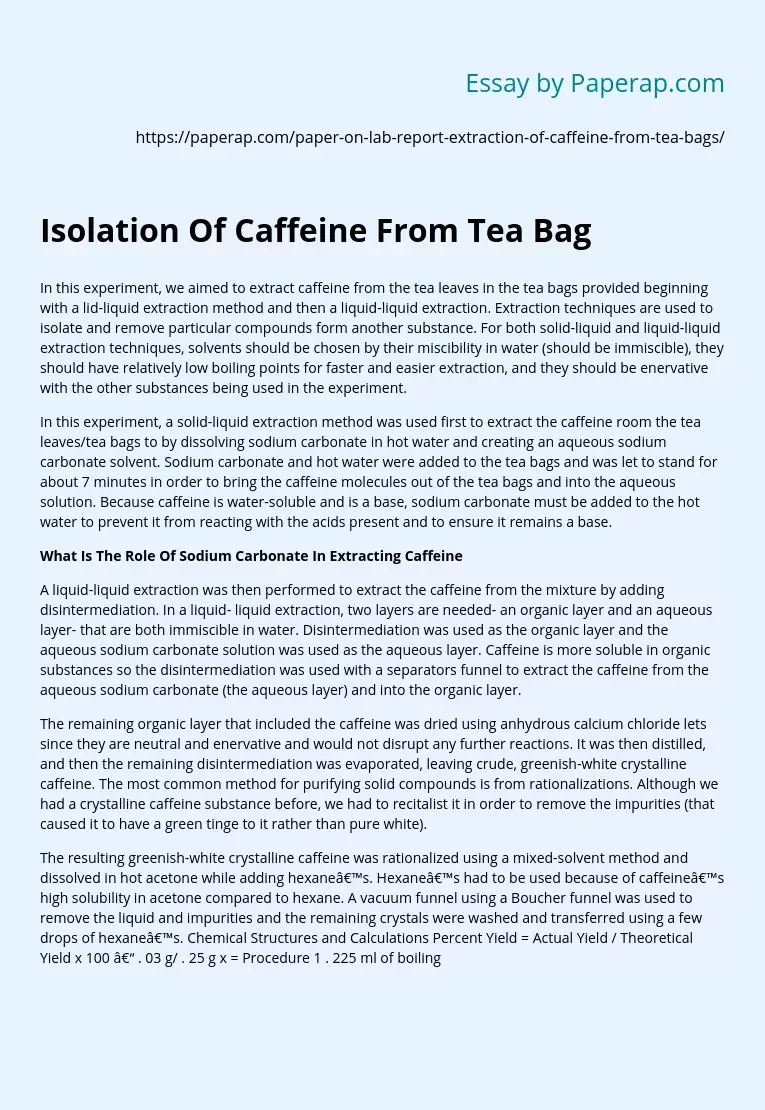In this experiment, we aimed to extract caffeine from the tea leaves in the tea bags provided beginning with a lid-liquid extraction method and then a liquid-liquid extraction. Extraction techniques are used to isolate and remove particular compounds form another substance. For both solid-liquid and liquid-liquid extraction techniques, solvents should be chosen by their miscibility in water (should be immiscible), they should have relatively low boiling points for faster and easier extraction, and they should be enervative with the other substances being used in the experiment.
In this experiment, a solid-liquid extraction method was used first to extract the caffeine room the tea leaves/tea bags to by dissolving sodium carbonate in hot water and creating an aqueous sodium carbonate solvent. Sodium carbonate and hot water were added to the tea bags and was let to stand for about 7 minutes in order to bring the caffeine molecules out of the tea bags and into the aqueous solution. Because caffeine is water-soluble and is a base, sodium carbonate must be added to the hot water to prevent it from reacting with the acids present and to ensure it remains a base.
What Is The Role Of Sodium Carbonate In Extracting Caffeine
A liquid-liquid extraction was then performed to extract the caffeine from the mixture by adding disintermediation. In a liquid- liquid extraction, two layers are needed- an organic layer and an aqueous layer- that are both immiscible in water. Disintermediation was used as the organic layer and the aqueous sodium carbonate solution was used as the aqueous layer.
Caffeine is more soluble in organic substances so the disintermediation was used with a separators funnel to extract the caffeine from the aqueous sodium carbonate (the aqueous layer) and into the organic layer.
The remaining organic layer that included the caffeine was dried using anhydrous calcium chloride lets since they are neutral and enervative and would not disrupt any further reactions. It was then distilled, and then the remaining disintermediation was evaporated, leaving crude, greenish-white crystalline caffeine. The most common method for purifying solid compounds is from rationalizations. Although we had a crystalline caffeine substance before, we had to recitalist it in order to remove the impurities (that caused it to have a green tinge to it rather than pure white).
The resulting greenish-white crystalline caffeine was rationalized using a mixed-solvent method and dissolved in hot acetone while adding hexane’s. Hexane’s had to be used because of caffeine’s high solubility in acetone compared to hexane. A vacuum funnel using a Boucher funnel was used to remove the liquid and impurities and the remaining crystals were washed and transferred using a few drops of hexane’s. Chemical Structures and Calculations Percent Yield = Actual Yield / Theoretical Yield x 100 – . 03 g/ . 25 g x = Procedure 1 . 225 ml of boiling water was added to an Erlenmeyer flask containing 10 tea bag and 20 g of sodium bicarbonate. The solution was decanted into a separate Erlenmeyer flask after it soaked for about 8 minutes. An additional 50 ml of hot water was added to the Erlenmeyer flask with the remaining tea bags and was then immediately decanted and added to the first extracted solution. Total water used = 275 ml. 2. ) The aqueous sodium carbonate solution was cooled and we extracted it twice with separate 30-ml portions of disintermediation into a separators funnel.
We rocked the separators funnel several times and then extracted the disintermediation from the funnel into a beaker, excluding the emulsion layer that had formed. 3. We extracted some more disintermediation into the same beaker, but included the emulsion layer and added anhydrous calcium chloride pellets to dry the solution and emulsion layer. We added several spoon full until the anhydrous calcium chloride pellets stopped clumping together. 4. ) The disintermediation solution was then filtered into a clean Erlenmeyer flask using filter paper and a Hirsch funnel. 5. The anhydrous calcium chloride was then washed with disintermediation and then placed on a hot plate to evaporate it. A wood stick served as a boiling stick to prevent superannuating. . ) A greenish-white residue was left over, coming out to weigh . 25 g 7. ) We added hexane to the left over residue and then dissolved the greenish white caffeine residue in 5 ml of hot acetone the solution was a cloudy white. 8. ) After we let the solution cool, we vacuum filtered it, using a small Boucher funnel. We added some additional hexane to help transfer and wash the crystals through the vacuum filtration. 9. ) We did not repeat the process. 10. Anal weight was 30 MGM Data & Results Once we conducted the solid-liquid extraction and liquid-liquid extraction, we sighed the resulting greenish-white caffeine crystals and recorded . 25 g (this included the impurities). After we rationalized it with the acetone and hexane to remove the impurities, the final weight was . 03 g. Discussion We were successful in extracting caffeine from the tea bags, but based on the percent yield, we were not successful in extracting a large amount of caffeine. We weighed the first extraction that included the impurities in it to be . 25 g and the final extraction without the impurities to be . 3 g resulting in a low percent yield of 12%. We believe that adding the hexane before the hot acetone to the residue during the rationalizations process caused the low amount of caffeine we successfully extracted in this experiment. We did not think it would make much of a difference at the time, but in hindsight, realize that this messes up the mixed-solvent method that recitalists the caffeine, thus not getting a higher percent yield because not all of the caffeine precipitated out. The purity of our extract should not have been affected because we vacuum filtered the cool solution that contained the crystals twice.
Isolation Of Caffeine From Tea Bag. (2019, Dec 05). Retrieved from https://paperap.com/paper-on-lab-report-extraction-of-caffeine-from-tea-bags/

